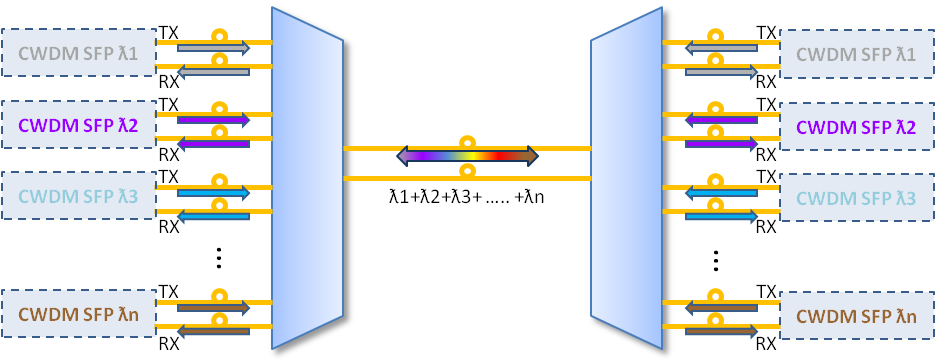As an extension of wavelength division multiplexing (WDM), coarse wavelength division multiplexing (CWDM) is a technology that multiplexes a number of optical carrier signals onto a single optical fiber through the use of different wavelengths (i.e., colors) of laser light. A CWDM SFP (Small Form-factor Pluggable) is on the SFP transceivers or socket switch or router port (as shown below). In the following figure, TX represents transmit, RX represents receive. Being a kind of compact optical transceiver, CWDM SFP transceivers are widely used in optical communications for both telecommunication and data communication. It is designed for operations in Metro Access Rings and Point-to-Point networks using Synchronous Optical Network (SONET), SDH (Synchronous Digital Hierarchy), Gigabit Ethernet and Fiber Channel networking equipment.

Three Components of CWDM SFP Transceivers
The CWDM SFP transceiver is consist of an un-cooled CWDM Distributed Feed Back (DFB) laser transmitter, a PIN photodiode integrated with a Trans-impedance Preamplifier (TIA) and a Microprogrammed Control Unit (MCU). The DFB laser used in the CWDM SFP transceiver transmitter is a 18 CWDM DFB wavelengths laser. It is well suited for high capacity reverse traffic. Obeying the standard diode equation for low frequency signals, The PIN photodiode has a 80km transmission distance. And the MCU is a high-speed, executive, input-output (I/O) processor and interrupt handler for the NRL Signal Processing Element (SPE).
Advantages of CWDM SFP transceivers
Using existing fiber connections efficiently through the adoption of active wavelength multiplexing, CWDM SFP transceivers have improved the designs of telecommunications devices and other technologies. Here are some advantages of CWDM SFP transceivers:
- Scalability and Flexibility—CWDM SFP transceivers can support multiple channels. It means that more channels can be activated as demand increases. CWDM SFP transceivers have a wide variety of network configurations that range from the meshed-ring configurations to the multi-channel point-to-point. In point-to-point configurations, the two endpoints will connect directly through a fiber link, allowing users to add or delete as many as eight channels at a time.
- Low Risks in Investment—Most CDWM SFP Transceivers have a low failure rate, which is less likely to be the reason why the user’s solution fails. It helps enterprises increase the bandwidth of the Gigabit Ethernet optical infrastructure without adding any additional fiber strands and can also be used in conjunction with other SFP devices on the same platform. Thus the user will be able to re-invest the capital saved by avoiding prematurely failed devices.
Selecting a Right CWDM SFP Transceiver
There are many kinds of CDWM SFP Transceivers in the market. Their wavelengths are available from 1270 nm to 1610 nm, with each step 20 nm. Different CDWM SFP Transceivers have different color codes, distances, date rates and laser operating wavelengths. For example, the CWDM-SFP-1470, which is colored gray, is one of Cisco CWDM SFP. It is a CWDM SFP transceiver that rates for distances up to 80 km and a maximum bandwidth of 1Gbps, operating at 1470nm wavelength. Customers may choose a CWDM SFP transceiver in accordance with their actual needs.

Applied to the access layer of Metropolitan Area Network (MAN), The CWDM SFP is a low-cost WDM transmission technology. Fiberstore provides the aforesaid CWDM-SFP-1470 and other types of CWDM SFP Transceivers, which are convenient and cost-effective solution for the adoption of Gigabit Ethernet and Fiber Channel (FC) in campus, data center, and metropolitan-area access networks.
Originally published at http://www.fiber-optical-networking.com/
No comments:
Post a Comment